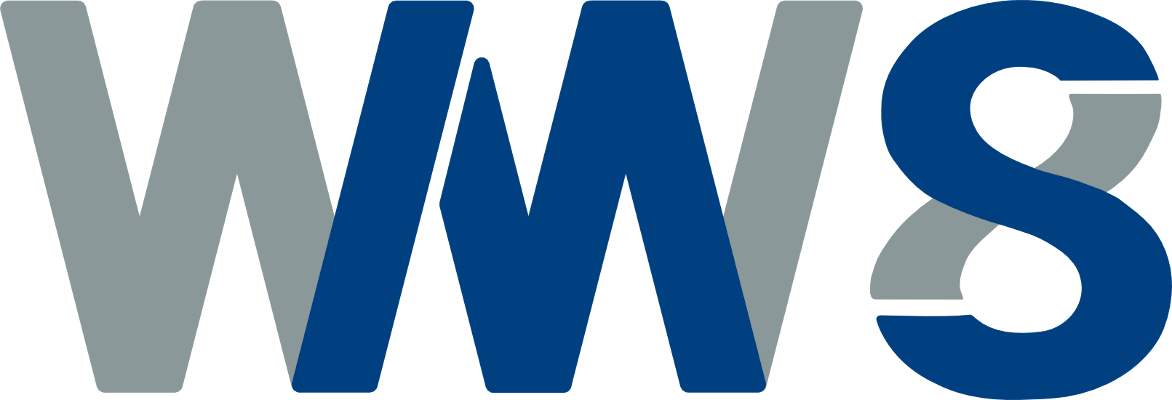Recommended Textbooks
Below is a list of books that we recommend as addition to our lectures and for further studies of materials simulation subjects. Most of the books are also available in the “Materials Simulation” section of the main library on the campus in Erlangen. Some of those are available as ebooks.
Introduction to Computational Materials Science: Fundamentals to Applications
Richard LeSar
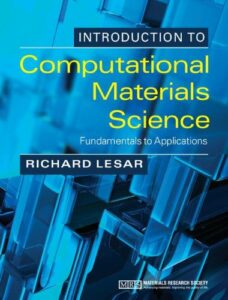
Emphasising essential methods and universal principles, this textbook provides everything students need to understand the basics of simulating materials behaviour. All the key topics are covered from electronic structure methods to microstructural evolution, appendices provide crucial background material, and a wealth of practical resources are available online to complete the teaching package. Modelling is examined at a broad range of scales, from the atomic to the mesoscale, providing students with a solid foundation for future study and research. Detailed, accessible explanations of the fundamental equations underpinning materials modelling are presented, including a full chapter summarising essential mathematical background. Extensive appendices, including essential background on classical and quantum mechanics, electrostatics, statistical thermodynamics and linear elasticity, provide the background necessary to fully engage with the fundamentals of computational modelling. Exercises, worked examples, computer codes and discussions of practical implementations methods are all provided online giving students the hands-on experience they need.
Continuum Mechanics and Thermodynamics: From Fundamental Concepts to Governing Equations
Ellad Tadmor, Ron Miller and Ryan Elliot
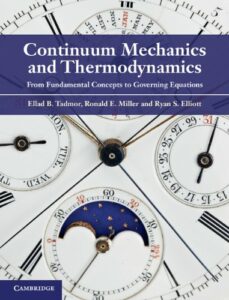
Ellad Tadmor, Ron Miller and Ryan Elliot
Continuum mechanics and thermodynamics are foundational theories of many fields of science and engineering. This book presents a fresh perspective on these fundamental topics, connecting micro- and nanoscopic theories and emphasizing topics relevant to understanding solid-state thermo-mechanical behavior. Providing clear, in-depth coverage, the book gives a self-contained treatment of topics directly related to nonlinear materials modeling. It starts with vectors and tensors, finite deformation kinematics, the fundamental balance and conservation laws, and classical thermodynamics. It then discusses the principles of constitutive theory and examples of constitutive models, presents a foundational treatment of energy principles and stability theory, and concludes with example closed-form solutions and the essentials of finite elements. Together with its companion book, Modeling Materials, (Cambridge University Press, 2011), this work presents the fundamentals of multiscale materials modeling for graduate students and researchers in physics, materials science, chemistry and engineering.
Modeling Materials: Continuum, Atomistic and Multiscale Techniques
Ellad Tadmor, Ron Miller
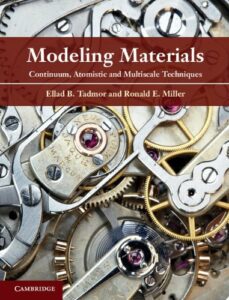
Material properties emerge from phenomena on scales ranging from Angstroms to millimeters, and only a multiscale treatment can provide a complete understanding. Materials researchers must therefore understand fundamental concepts and techniques from different fields, and these are presented in a comprehensive and integrated fashion for the first time in this book. Incorporating continuum mechanics, quantum mechanics, statistical mechanics, atomistic simulations and multiscale techniques, the book explains many of the key theoretical ideas behind multiscale modeling. Classical topics are blended with new techniques to demonstrate the connections between different fields and highlight current research trends. Example applications drawn from modern research on the thermo-mechanical properties of crystalline solids are used as a unifying focus throughout the text. Together with its companion book, Continuum Mechanics and Thermodynamics (Cambridge University Press, 2011), this work presents the complete fundamentals of materials modeling for graduate students and researchers in physics, materials science, chemistry and engineering.
First Course in Finite Elements
Jacob Fish and Ted Belytschko
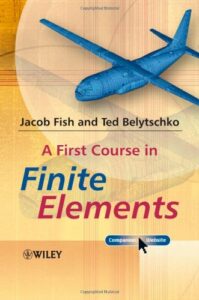
Developed from the authors, combined total of 50 years undergraduate and graduate teaching experience, this book presents the finite element method formulated as a general-purpose numerical procedure for solving engineering problems governed by partial differential equations. Focusing on the formulation and application of the finite element method through the integration of finite element theory, code development, and software application, the book is both introductory and self-contained, as well as being a hands-on experience for any student. This authoritative text on Finite Elements:
- Adopts a generic approach to the subject, and is not application specific
- In conjunction with a web-based chapter, it integrates code development, theory, and application in one book
- Provides an accompanying Web site that includes ABAQUS Student Edition, Matlab data and programs, and instructor resources
- Contains a comprehensive set of homework problems at the end of each chapter
- Produces a practical, meaningful course for both lecturers, planning a finite element module, and for students using the text in private study.
- Accompanied by a book companion website housing supplementary material that can be found at http://www.wileyeurope.com/college/Fish.
A First Course in Finite Elements is the ideal practical introductory course for junior and senior undergraduate students from a variety of science and engineering disciplines. The accompanying advanced topics at the end of each chapter also make it suitable for courses at graduate level, as well as for practitioners who need to attain or refresh their knowledge of finite elements through private study.
Introduction to Dislocations
Derek Hull and D.J. Bacon
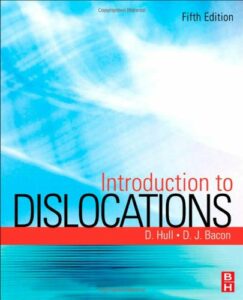
Derek Hull and D.J. Bacon
Introduction to Dislocations was first published in 1965 in a series aimed at undergraduate and postgraduate students in metallurgy and materials science and related disciplines. At the time, the subject was maturing and it was expected that ‘dislocation concepts’ would remain a core discipline for a very long time. As expected, the book has been, and remains, an important undergraduate text all over the world.
A wider range of materials has emerged since 1965, most notably in the field of electronics and micro-engineering. The principles of dislocation theory still apply but some of the detail requires further treatment.
This fourth edition provides an essential basis for an understanding of many of the physical and mechanical properties of crystalline solids. This new edition has been extensively revised and updated to reflect developments in the understanding of the subject, whilst retaining the clarity and comprehensibility of the previous editions.
A Primer on Scientific Programming with Python
Hans Petter Langtangen
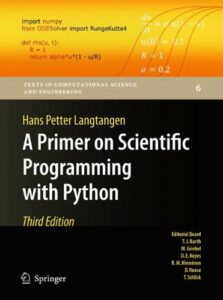
The book serves as a first introduction to computer programming of scientific applications, using the high-level Python language. The exposition is example- and problem-oriented, where the applications are taken from mathematics, numerical calculus, statistics, physics, biology, and finance. The book teaches “Matlab-style” and procedural programming as well as object-oriented programming. High school mathematics is a required background, and it is advantageous to study classical and numerical one-variable calculus in parallel with reading this book. Besides learning how to program computers, the reader will also learn how to solve mathematical problems, arising in various branches of science and engineering, with the aid of numerical methods and programming. By blending programming, mathematics and scientific applications, the book lays a solid foundation for practicing computational science.
